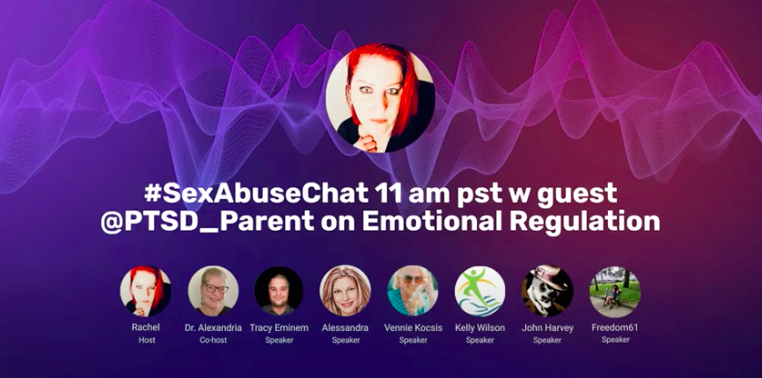Learning how to connect with emotions and feelings is an essential process for trauma survivors. I was honored to be asked as a guest on Rachel Thompson’s Twitter program, #sexabusechat.
Sexual Abuse & Emotions and Feelings
In the process of going through trauma (especially sexual abuse), our survival mechanism is to disconnect the body and the brain. The first things to be shut down are emotions and feelings – sensing, allowing, connecting, identifying, processing, and communicating.

Our emotions are first felt in our bodies, and the survival instinct to disconnect the body from the brain keeps us from processing, releasing, and making meaning from these emotions and feelings. This energy lives in our cells, muscles, and tissues, making our bodies more and more uncomfortable. (For a lot more about this, check out The Body Keeps the Score.)
One of my passions in this trauma and grief recovery work is encouraging and teaching people how to feel safe and secure while reconnecting their bodies and brains. Processing emotions and feelings can feel threatening. It takes gentleness, compassion, and curiosity to begin to open the door to this kind of reconnection.
What is #sexabusechat?
The community #sexabusechat draws survivors of childhood sexual abuse and sexual assault. This chat takes place primarily on Twitter, with weekly spotlights on advocates for recovery from this type of trauma. There is a guest speaker each week, and listeners can join in with a link – no need to be active on Twitter to listen in and ask questions.
My episode was about emotions and feelings and how to deal with them as a survivor of childhood sexual abuse and all of the trauma that goes along with that. Some of the topics covered include why we as sexual abuse survivors have trouble regulating emotions, how to deal with emotional responses and PTSD triggers, and a helpful acronym for regulating emotions. Take a listen below ~
Additional Resources From This Episode
There was a lot to cover, and the questions and collaboration were wonderful. Some of the additional mentions include these articles that focus on the connection between sexual abuse survivors and addiction.
Understanding the Link Between Sexual Abuse & Addiction | Tranquil Shores
“A study in the Journal of Traumatic Stress indicated 90 percent of women who became dependent on alcohol were violently abused by a parent or were sexually traumatized as a child.
Additionally, youth with a history of child sexual abuse were 2-3x times more likely to have drug dependence than peers who were not traumatized.
Some studies indicate that drug abuse is more common than alcohol use in adolescents who have been sexually traumatized.”
Sexual Trauma and Addiction: Understanding Child Sexual Abuse and Drug Use – Drug Rehab Options
Speaking of Addiction, Seeking Safety Coming Soon
One of my goals is to work with people with PTSD using the Seeking Safety curriculum. I’ve been through a couple of groups using Seeking Safety and really liked what it offered, as well as the group dynamic. This group is for those who have experienced trauma, or have PTSD, or are in substance use recovery, or any or all of the above.
If you’re interested in a future Seeking Safety group, sign up below:
Try Trauma Recovery & Grief Recovery Coaching

Sign up here to get a free copy of Five Things Every Trauma Survivor Needs to Know &
61 Tips About the Grief Experience.
Find out more about Trauma and Grief Recovery Coaching
I offer one-on-one sessions, groups, PTSD Remediation, and classes. Appointments are offered in-person and online.
Try Trauma Recovery and Grief Recovery Coaching for Free! Book an appointment or schedule your FREE 30-minute discovery call to learn more!
